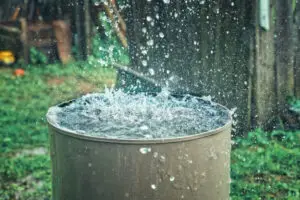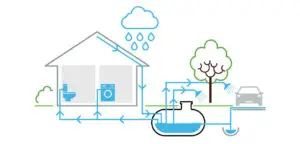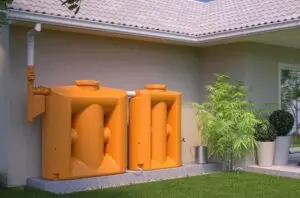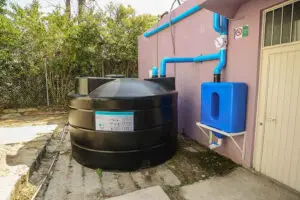Rainwater harvesting is a very important alternative that you can apply if you want to save water and reduce your consumption rate, and it is very beneficial especially in a world where water scarcity is a growing concern. This article discusses the many aspects of rainwater harvesting and utilization, from the environmental and economic benefits it offers to best practices for integrating it into existing plumbing systems.
We will explore methods for assessing the quality of collected rainwater, the most common domestic and industrial applications, and the types of rainwater harvesting systems available, as well as maintenance and optimization strategies. In addition, the current regulations and solutions for the most frequent challenges in water harvesting in different climates will be reviewed, with a special focus on arid areas where every drop counts.
Benefits of rainwater harvesting
Rainwater harvesting offers a number of benefits that position it as an effective and sustainable solution for water resource management.
First, rainwater is naturally clean compared to other freshwater sources, which simplifies its treatment and makes it suitable for a variety of uses, from irrigation to non-potable household uses. This characteristic reduces the need for complex and costly purification processes, favoring its use in different contexts.
In addition, rainwater is a completely free resource and does not depend on water supply companies, which provides greater autonomy to those who choose to collect it. This independence also contributes to a significant reduction in the costs associated with drinking water consumption, a crucial factor for both households and companies seeking to reduce their operating expenses.
In addition, the infrastructure required for rainwater harvesting, storage and distribution is relatively simple and inexpensive to implement. This makes rainwater harvesting accessible and feasible in a wide variety of environments, from densely populated urban areas to rural areas.
Taken together, these benefits underscore the importance of rainwater harvesting as an essential practice in sustainable water management, offering a resilient and adaptable alternative to fluctuations in water resource availability.

Methods to improve rainwater quality
Although rainwater at its source is like distilled water, it is not fit for human consumption, the problem lies in the polluted environment in which much of the population lives, especially in cities.
In urban areas, raindrops may have captured pollutants such as carbon monoxide. This gas is generated from the burning of fuels, wood and similar materials.
The smoke rises, increasing the concentration of carbon monoxide in the atmosphere, and as rain falls, the water may become contaminated. There are also other factors such as bacteria with which rainwater can become contaminated during its descent to the surface or when it comes into contact with different surfaces, such as roofs and floors. Therefore, it is essential to treat rainwater before consumption.
To achieve this we can implement a filtration system where the collected rainwater is subjected to several processes to make it suitable for human consumption, different methods can be chosen such as a filtration, disinfection and purification system; Rainwater tanks already come with sediment filters so if we connect it to an advanced filtration system the water we obtain will be of excellent quality, to even better optimize our collection system we can divide our rainwater supply network so that the purified rainwater is used only for consumption and tasks that require excellent water quality and the other part of the network for tasks that do not require such high quality.
Keep in mind that we can do the work ourselves but there are also companies that facilitate the process and help with the installation of these systems, sometimes it is better to opt for those companies as most have their own complete rainwater harvesting system so the whole filtration system already comes integrated and we don’t have to figure out how to adapt one part of the system with another part of the system of another brand.
We can also choose simpler methods, such as boiling water or chlorination. For one liter of water, one drop of chlorine at a concentration of 5% should be added. For 20 liters, 20 drops of chlorine are used; for 200 liter ponds, 2 plugs of chlorine should be added; and for one thousand liters, 10 plugs are added. Then, mix well and wait 30 minutes before consuming the water.

Once we have cleaned the rainwater we can choose to analyze its quality and thus make sure that it has a good quality. An effective way to do this is by using water testing kits. These kits are affordable tools that allow users to test at home to determine the quality of the collected water.
They generally include reagents and devices that measure various parameters, such as the presence of bacteria, heavy metals and other contaminants. By following the kit’s instructions, it is possible to obtain reliable results that indicate whether the water is safe to drink.
Another important aspect to consider is the pH of the rainwater. A pH meter is a device that allows the acidity or alkalinity of water to be measured. The ideal pH for drinking water is between 6.5 and 8.5. If the pH of rainwater is outside this range, it may indicate the presence of contaminants that could affect health. For example, a very low pH may suggest the presence of acids, while a high pH may indicate contamination by alkaline substances.
In summary, all these methods are effective and we must choose the ones that best suit our needs and budget, it should also be emphasized that although all these methods are effective does not mean that all will leave the water 100% pure, even purifying it does not ensure that it is 100% pure, however making it drinkable is more than enough to consume it and use it for other activities of potable use such as washing dishes or bathing.
Rainwater applications in the home
As you can see, rainwater can be suitable for human consumption as long as we implement an adequate system to improve its quality. This implies the installation of filters and purification systems that eliminate impurities and contaminants. However, if we decide not to use it for drinking, we can take advantage of it in various ways in our daily activities. For example, the collected water can be used for garden irrigation, outdoor cleaning, or to fill swimming pools, wash the car or even wash clothes.
Furthermore, if we optimize our rainwater harvesting system by adding water saving devices, dual flush toilets, low flow showerheads and faucets etc…. We will be able to maximize the efficient use of rainwater. These devices not only help to better manage the captured water, but also reduce the cost on our utility bills.

Apart from these domestic uses, rainwater can also be used for industrial purposes. Many industries use it for cooling, heating, cleaning machinery and in some stages of production. For example, in agriculture, it can be used to irrigate crops, which not only reduces dependence on drinking water sources, but also contributes to environmental sustainability by reducing the extraction of water from aquifers, or in livestock farming to supply water to livestock, which saves a lot of money on water bills.
Rainwater harvesting and use not only represents a viable alternative for consumption and domestic use, but is also a key strategy in water management. Implementing rainwater harvesting and storage systems can contribute significantly to water conservation, especially in regions where water is scarce.
How rainwater harvesting systems work
As we have seen why rainwater harvesting is very beneficial, we will now talk about the system capable of harvesting this resource. The most common rainwater harvesting system is composed of five main components: the collection module, the conveyance module, the filtration system, the storage and the distribution. Each of these elements plays a crucial role in the process.
The first thing a system does is to collect rainwater using collection gutters installed on roofs and around buildings, a stormwater drainage system, or an infiltration system. This part of the system directs rainwater into the conveyance system. Regular maintenance is essential to prevent the accumulation of leaves and other debris, which can clog the flow and contaminate the water. Keeping these gutters clean not only improves water quality, but also prolongs the life of the system.
After collection, rainwater must be conveyed through the conveyance module. This module is composed of drainage pipes that allow the efficient flow of water to the storage. The proper slope of these pipes is essential to avoid stagnation and spills. In addition, it is advisable to install connection fittings that ensure a tight seal, minimizing the risk of leaks and guaranteeing that the water remains clean during transport.

The collected water is not suitable for immediate consumption, so it is directed to a filtration system, which is why there are storage tanks that already come with this system. These filtration systems are in charge of filtering the rainwater separating sediments, leaves or any other type of waste that worsens its quality, these filters can be sand filters, mesh filters etc…. This step is crucial, as the filtered water can be used for many activities.
Once filtered, the rainwater stays right there in the storage tank. These tanks when used for domestic purposes are mostly polyethylene tanks which are resistant and designed to withstand adverse weather conditions. Their capacity can vary between 5,000 and 10,000 liters, which allows them to capture large volumes during rainfall. It is important to note that these tanks do not require electricity, as they usually use a manual pump to extract the water, which makes them very efficient and sustainable.
Finally, in the distribution phase, the stored water is made available for use. By opening a tap, the water flows to the points of use, such as dispensers or irrigation systems. The use of a hand pump makes it possible to control the amount of water withdrawn, thus avoiding waste. In addition, overpressure valves can be installed to regulate the water pressure in the system, protecting the pipes and ensuring a constant flow. There are even rainwater supply systems that already come with a more advanced filtration system that allow to better treat the water for more potable uses, these filters can be activated carbon filters.
Types of rainwater harvesting systems
Previously we saw how is the collection process in a rainwater harvesting system, although in most systems on the market the process is generally the same there are certain characteristics that can differentiate one system from another, these characteristics are determined by the different types of collection systems, types of storage tanks, pumping system etc … So now we will talk about the types of rainwater harvesting systems that exist and thus get a better view of what type of system suits us best.
Let’s start with pumping systems, there are mainly three types on the market: direct pumping, indirect pumping and indirect gravity. In some circumstances, it is possible to have a completely gravity system, although this method is not very common.
Direct (submersible) pumping: This rainwater harvesting system is ideal for domestic use and is one of the simplest to install. The pump is placed inside a subway tank and the collected water is pumped directly for different uses in the home.
Direct pumping (suction): This rainwater harvesting system has the pump located outside the tank and is recommended for large areas or properties with high water consumption.
Indirect gravity: In this rainwater harvesting system, the accumulated water is first pumped to an elevated tank (header tank), and the pump is only activated when it is necessary to fill the collector tank.
There are different types of storage tanks, just as there are various pumping methods. For example, outdoor modular tanks can store large amounts of rainwater for extended periods without requiring significant construction work. Each unit typically holds up to 1,000 liters and can be connected with others for increased capacity, as they are made from lightweight materials that make installation easy. However, they take up considerable space and can be aesthetically challenging to conceal.

Subway tanks can also store large volumes of rainwater without impacting aesthetics. However, their underground installation is more complex and expensive, so it’s best to plan for them at the construction’s outset. New alternatives, like modular subway tanks, have load-bearing capacities and can be installed in building foundations. Their modular design allows for covering the necessary surface by adding and connecting modules of about 200 liters each.
On the other hand, dispenser tanks are smaller units linked to rainwater drainage systems. They collect water for use when needed. While they don’t hold as much as the larger tanks, they can still store up to 100 liters, and their size allows for easy aesthetic integration, even serving as decorative pieces.
Finally, decorative tanks are medium-sized elements connected to rainwater collection, designed for aesthetic appeal. They can resemble large vases or pots and may store over 600 liters. Some include filtration systems to make the water drinkable. However, their aesthetic function makes it difficult to connect them to the sanitary supply network, so many have their own dispensing systems.
The type of storage can vary based on the activity, the amount of water needed, and the system’s location. For instance, ferrocement tanks can be used in rural areas, geomembrane storage in agricultural regions, and cisterns in urban settings. Additionally, we must select a tank of the appropriate size and material. Polyethylene is the most common, but there are also reinforced concrete and steel tanks, among others.

Geomembrane
Another of the most important factors that differentiate rainwater harvesting systems is the method of collection, for example roof catchment is the most common method of rainwater harvesting. It consists of using impervious surfaces, such as building roofs, to capture water. The rainwater is channeled through gutters and downspouts to a storage tank. This system is efficient and easy to implement, especially in urban areas. The advantage of this system is that it is easier to install than other collection methods, it also has a high collection capacity and can be used in residential and commercial buildings.
Another method of rainwater harvesting in rainwater harvesting systems is Surface Harvesting, these systems use areas of land, such as yards or gardens, to collect rainwater. Instead of relying on roofs, the water is directed to a catchment area where it can infiltrate into the ground or be stored in subway tanks. This method is ideal for rural areas or on land with good permeability. This system promotes aquifer recharge and can be integrated into natural landscapes.
And finally there is the Runoff Water Harvesting, this type of system collects the water that flows over the surface of the land during rainfall. Ditches, canals or retention ponds can be used to direct the water to a storage system. This method is useful in areas where rainfall generates significant runoff. This system takes advantage of water that would otherwise be lost and can help control flooding.
With this in mind we can realize that there are many ways in which a rainwater harvesting system can be implemented, however when choosing our system it is important that we take these considerations into account in order to choose the type of system with the characteristics that best suit us, since as we have seen not all systems are exactly the same and this means that the installation of the plumbing system is not the same in all of them.
System maintenance: general tips
With everything we have seen above, there is no doubt that a rainwater harvesting system is an excellent way to take advantage of rainwater, but for it to work optimally, regular maintenance is essential. Proper care not only prolongs the life of the system, but also ensures the quality of the water collected. Below are general tips and guidelines for maintaining a rainwater harvesting system.
Regular Inspection: It is essential to perform regular inspections of the system, at least twice a year, preferably in spring and fall. During these inspections, check the condition of the catchment surface, gutters, downspouts and storage tank. Look for signs of clogging, such as leaves, branches or accumulated dirt. It is also important to perform a rubber gasket inspection to make sure there are no leaks.
Gutter and Downspout Cleaning: Gutters and downspouts are critical components that can easily become clogged. Be sure to clean them regularly, especially after heavy storms or during leaf-fall seasons. Use drain cleaning tools and pipe cleaners to remove any debris and ensure that water flows freely into the storage tank.
Storage Tank Maintenance: The storage tank should be checked and cleaned at least once a year. Remove any sediment that has accumulated on the bottom, as it can affect water quality. If the tank has a lid, make sure it is tightly sealed to prevent the entry of contaminants and the proliferation of insects. Use sealing tools to ensure that the gaskets are tight.
Filter Inspection and Maintenance: Filters are essential to ensure that the collected water is free of impurities. Check filters regularly and perform filter maintenance or replace filters as needed. Screen filters should be cleaned with pressurized water, while sand or carbon filters should be replaced according to the manufacturer’s recommendations.
Checking the Pumping System: If your system includes a pump, perform performance tests at least once a year. Check for leaks and that the pump is in good condition. Clean the pump filter to prevent clogging and make sure the electrical wiring is in proper condition. Consider using unclogging equipment if you find blockages in the pipes.
Control Valves: Control valves are crucial to the flow of water. Perform valve checks to ensure that all valves are functioning properly and are not leaking. Lubricate valves as needed and replace any damaged valves immediately.
Water Quality Monitoring: It is important to make sure that the collected water is safe for use. Test the water quality at least once a year for contaminants. If the water is to be used for human consumption, consider installing an additional treatment system.
Rainy Season Preparedness: Before the rainy season, make sure the entire system is in optimal condition. Perform a thorough cleaning and check all components. This will help maximize water collection during the rainy season and minimize the risk of problems. Use pressure gauges to verify that the system is functioning properly.
Maintenance Documentation: Keep a record of all maintenance activities performed. Note the dates, tasks performed, and any relevant observations. This will help you identify patterns and plan future maintenance activities.

Maintaining a rainwater harvesting system is essential to ensure its efficiency and durability. By following these guidelines and tips, you can enjoy a system that not only saves water, but also contributes to environmental sustainability. Remember that a well-maintained system not only benefits your home, but also the environment around you.
Solutions for common problems in a rainwater harvesting system
If we do maintenance on our system and it still has a problem, how can we fix it? We will talk about that below and give you a series of guidelines that you can follow in certain occasions in order to prevent your rainwater system from stopping working.
Let’s start with the repair of Leaks in the Pipes, when a leak is detected in the pipes, the first thing is to locate the exact source of the water leak. Once identified, the water supply to the system must be shut off to prevent further losses. Then, use a leak repair kit that contains silicone tape, epoxy putty or a repair clamp. Clean the surface around the leak to make sure it is free of dust and moisture.
Apply the silicone tape by wrapping it tightly around the pipe, completely covering the leak. If you use epoxy putty, mix the material until you get a uniform consistency and apply it to the affected area, pressing so that it adheres well. If you use a clamp, place it over the leak and tighten the screws until it is tight. Allow the repair to dry or harden according to the manufacturer’s instructions before reactivating the system.
Another common problem that arises is clogged pipes, which can dramatically reduce the efficiency of the system. To clear these blockages, use unclogging tools such as a plumber’s snake or a pressure plunger. Insert the snake into the affected pipe and slowly twist it as you go, allowing the end to break up and dislodge the clog. If you prefer to use a pressure plunger, be sure to seal any air leak points in the pipe before applying pressure. This will help the force of the water push the blockage out. Once the blockage is cleared, it is recommended to flush the pipe with clean water to ensure that no debris remains. Also, consider installing replacement filters at the system inlets to prevent future clogs.
On the other hand, replacing damaged valves should be a priority when they give rise to problems since valves are critical components in controlling water flow. To start, turn off the water supply and drain the section of the pipe where the faulty valve is located. Use a wrench or pipe wrench to loosen and remove the old valve. When installing the new valve, be sure to use Teflon tape on the threads to ensure a tight seal. Screw the valve into place and tighten it firmly. Once installed, slowly turn on the water supply and check for leaks. If everything is in order, you can restore full water flow. To monitor the performance of the new valve, use flow meters that will allow you to detect any irregularities in the operation of the system.
Finally, it is crucial to maintain constant control over the water level in storage tanks to avoid overflows or dry running of pumps. Installing a reliable water level sensor is essential. If the sensor is faulty, carefully remove it following the manufacturer’s instructions and replace it with a new one. Make sure the sensor is correctly calibrated and positioned in the tank. In addition, it is advisable to periodically check the condition of the sensor and clean any sediment buildup that may affect its accuracy.
By following these detailed steps and using the appropriate tools and materials, it is possible to effectively solve the most common problems in a rainwater harvesting system. Keep in mind that although these guidelines are almost always effective, sometimes the problem is much larger and will require the intervention of a professional plumber.

storage tank leak
Regulations and Rules Aspects
These types of aspects are not the same in all places, they always tend to vary, so it is essential to be informed about local regulations. This includes checking if permits are required, knowing the water quality standards and understanding the limitations on its use.
For example, rainwater harvesting in the United States is not illegal but may have a certain level of restriction in some states, in others you may only need a permit and in others there is no regulation at all, even going so far as to promote this practice. The best thing you can do is check the local regulations in your area. The World Water Reserve published a complete state-by-state guide to explain which states do and do not allow rainwater harvesting.
Most local authorities give advice on good practices in the installation and use of these systems, for example not connecting the system to the drinking water distribution system or for example guidelines on maintenance to avoid dengue or other types of problems or the review of the local plumbing code during the installation of the system etc…
In summary, being well informed about local regulations and adopting appropriate practices not only guarantees legal compliance, but also maximizes the environmental and economic benefits of this valuable source of water.
Conclusion
This article highlighted the importance of rainwater and how to utilize it through collection systems. We learned that rainwater can benefit not only homes but also agriculture, livestock, and various industries.
We also discovered that collection systems vary based on their intended use. Factors like installation, maintenance, and repair differ, which is useful to know. For instance, if there’s a leak in our system, having basic knowledge can help us address the issue. Proper maintenance can also save money on service costs.
Of course, if we know what we’re doing or follow an expert plumber’s guidance, we can handle it ourselves. Otherwise, we can rely on professionals. The key is to maximize the benefits of rainwater for our specific needs.